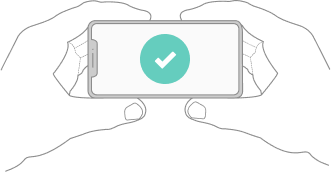# Impulse Control

# What does it measure?
The Impulse Control test measures a patient's inhibitory control and basic executive function when compared to simple reaction time.
# Test Administration
The Impulse Control test takes approximately 1 minute to complete.
Before you begin your test, ensure your device is at maximum brightness and hold the device in landscape with both hands.
# Step 1
When you begin your test, your screen will appear white. Hold the device steady during this time.

# Step 2
After a random amount of time, either a green circle with a check mark or a red circle with an X will appear on your screen.


When the device screen turns orange, move the device in any direction as fast as you can. The device will vibrate once it has detected your movement. The device screen will then change back to white and you will be back at Step 1.
# Repeats Steps 1 & 2
The test will continue to cycle you through steps 1 and 2, measuring each cycle's respective reaction time. The number of cycles per test vary based on the tester's performance, ensuring accuracy.
# Results Interpretation
Impulse control has the same scoring mechanism as the simple reaction time. The score score is the average of the 3 median measures or the average of the remaining scores after dropping the fastest and slowest score.
A patient's impulse control score should be slower (lower sway score) than their simple reaction time test score, typically by 40 - 100ms.
By comparing the results of a patient's impulse control and simple reaction time tests, we can now derive their "Basic Executive Function" time, which is the difference between these two scores. For example, if a patient's simple reaction time score was 250ms and their impulse control time was 350ms, we can derive that the "Basic Executive Function" time is 350ms - 250ms = 100ms.
You can find more information on Impulse Control normative data here
